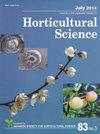A Sample Preparation Method for Direct and Non-direct PCR in Woody Plants
Journal of The Japanese Society for Horticultural Science
Pub Date : 2013-01-01
DOI:10.2503/JJSHS1.82.14
引用次数: 7
Abstract
Despite recent advances in DNA analysis techniques, the process of acquiring purified DNA is particularly costly and time-consuming in woody plants. The ability to obtain purified DNA is frequently hindered by the presence of secondary compounds, including polyphenols and polysaccharides. In this study, we developed a sample preparation method for direct and non-direct PCR that is highly reproducible and cost-effective. This method entails pricking a leaf sample with a toothpick and dissolving the collected DNA in a PCR mixture or TE0.2 buffer solution. We confirmed the utility of the method using seedlings derived from backcrossed hybrids of Citrus hassaku hort. ex Y. Tanaka × Poncirus trifoliata (Linn.) Raf. Using a direct PCR method, we obtained 99% amplification success rate for the 1200 bp CTg12A region. PCR amplification from DNA extracts, which was also produced by our method, succeeded in 96–100% of samples for five different DNA markers, except for CTg12A, where it was only 86%. We were able to process and commence PCR amplification of 95 leaf samples in 1.5–2.0 h, in contrast to 23 h using conventional methods. We also demonstrated the broader applicability of this method by extending our study to 18 other fruit trees and ornamental woody plants. PCR products were generated for all 18 tested species using chloroplast accD and rbcL markers, and for Japanese chestnut, mango, and Japanese pear using their species-specific SSR markers. Our new method might be suitable for analyses which handle large number of samples, such as marker-assisted selection and cultivar discrimination, and holds promise for use in DNA marker typing in various kinds of woody plants.木本植物直接与非直接PCR样品制备方法研究
尽管DNA分析技术最近取得了进展,但在木本植物中获得纯化DNA的过程特别昂贵和耗时。获得纯化DNA的能力经常受到二级化合物(包括多酚和多糖)存在的阻碍。在本研究中,我们开发了一种高重复性和高性价比的直接和非直接PCR样品制备方法。这种方法需要用牙签刺穿叶子样本,并将收集的DNA溶解在PCR混合物或TE0.2缓冲溶液中。本研究以回交杂交柑橘为样本,验证了该方法的有效性。例田中×三叶Poncirus trifoliata (Linn.)英国皇家空军。采用直接PCR法,对1200 bp的CTg12A区扩增成功率为99%。用我们的方法对DNA提取物进行PCR扩增,除了CTg12A只有86%外,对5种不同的DNA标记的扩增成功率为96-100%。我们能够在1.5-2.0小时内处理并开始95个叶片样品的PCR扩增,而传统方法需要23小时。我们还通过将研究扩展到其他18种果树和观赏木本植物,证明了该方法的更广泛适用性。利用叶绿体accD和rbcL标记对所有18个被试物种进行PCR扩增,利用栗子、芒果和梨子的物种特异性SSR标记进行PCR扩增。该方法适用于标记辅助选择和品种鉴别等大量样本分析,有望应用于各种木本植物的DNA标记分型。
本文章由计算机程序翻译,如有差异,请以英文原文为准。
求助全文
约1分钟内获得全文
求助全文
来源期刊
自引率
0.00%
发文量
0
审稿时长
>36 weeks

 求助内容:
求助内容: 应助结果提醒方式:
应助结果提醒方式:


